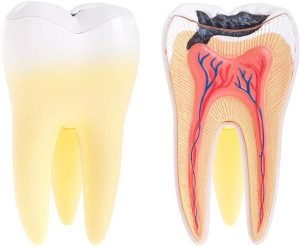 What is it?
What is it?
Dental caries is the medical term for tooth decay or cavities. It is caused by acid which dissolves tooth enamel.
Many different types of bacteria normally live in the human mouth. They build up on the teeth (along with saliva, bits of food and other natural substances) in a sticky film called plaque.
Plaque forms especially easily in certain places. These include:
- Cracks, pits or grooves in the back teeth
- Between teeth
- Around dental fillings or bridgework
- Near the gum line
When we eat anything containing sugar the plaque bacteria converts this sugar into acids. Sugar is found in a wide range of sources including lollies, chocolate, soft drink, fruit, honey and both processed and unprocessed sugars. The acids produced by the plaque and sugar dissolve minerals in the surface of the tooth. This erodes or creates pits in the enamel that are too small too see at first. But they get significantly larger over time.
The damage can occur anywhere the tooth is exposed to plaque, sugar and acid. This includes the hard outer enamel on the tooth crown or parts of the root that have been exposed because of receding gums. Once decay penetrates the protective enamel, it can enter the softer, vulnerable dentine. This is the main body of the tooth. A cavity can even penetrate the soft tooth pulp reaching the sensitive nerves within it.
Symptoms
Early caries may not have any symptoms. Later, when the decay has eaten through the enamel, the teeth may become sensitive to sweet foods or to hot and cold temperatures. Eventually the tooth often becomes excruciating painful before eventually dying. Soon after this an abscess will develop.
Diagnosis
A dentist will look for caries at each periodic examination. The dentist will look at the teeth and will probe them with a tool called an explorer to look for pits or areas of damage. X-rays will be taken on a set schedule, or more often if the dentist suspects hidden caries.
Expected Duration
How long caries lasts is determined by the stage at which it is found. White spots may indicate early caries that has not yet eroded through the enamel. Early caries may be reversed if acid damage is stopped and the tooth is given a chance to repair the damage naturally.
Caries that has destroyed enamel cannot be reversed. Most caries will continue to get worse and deeper. With time, the tooth may decay down to the root. The amount of time this progression takes will vary from person to person. Caries can erode to a painful level within months or years.
Prevention
You can prevent cavities by reducing the amount of plaque and bacteria in your mouth. The best way to do this is by using excellent brushing and flossing techniques daily and getting professional dental cleanings twice a year.
You also can reduce the amount of acid in your mouth by eating sugary or starchy foods less frequently during the day. Your mouth will remain acidic for considerable time after eating, so snacking is more likely to lead to caries than avoiding between-meal snacks. Chewing sugar free gum that contains xylitol helps to counteract the acidity that occurs after eating.
Teeth can be strengthened by fluoride. A dentist can evaluate your risk of caries and then suggest appropriate fluoride treatments. Molars can be protected with fissure sealants which can be an important treatment for both adults and children.
Treatment
The standard treatment for a cavity is to fill the tooth. First, the dentist will numb the area. Then the decayed material in the cavity is removed and the cavity is filled. Fillings usually are made of dental amalgam or composite resin.
Amalgam is a silver-gray material made from silver alloyed with mercury and copper or other metals to make it more durable. Composite resin offers a better appearance because it is tooth-colored. At Castlemaine Smiles Dental we do not place mercury containing fillings. Gold inlays may be used if greater strength is needed, gold fillings are more long lasting but also more expensive.
If a cavity is large, the remaining tooth may not be able to support the amount of filling material that would be needed to repair it. In order to prevent further breakage of the weak tooth the dentist will remove the decay, fill the cavity, and cover the tooth with an artificial crown.
Sometimes the part of the tooth you can see remains relatively intact, but there is damage inside the tooth. In these cases a root canal treatment will be necessary. In this procedure, the dentist removes the tooth’s pulp and replaces it with an inert material. In most cases, the tooth’s natural crown will need to be replaced with an artificial crown.
When to call a Professional
The early stages of decay are usually painless. Only regular professional examinations and X-rays can detect early trouble, so in order to reduce the chances of experiencing large harder to treat cavities, regular examinations are vital. If you do develop sensitivity to chewing or to hot, cold or sweet foods or drinks, contact your dentist immediately.
Prognosis
If a cavity is not treated, it will cause the tooth to erode significantly. Eventually, the tooth may be destroyed by uncontrolled decay.
Having caries increases your risk of more caries for several reasons:
- The same oral care and dietary habits that led to the decay of teeth by plaque, sugar and acids may cause more decay.
- Bacteria tend to stick to fillings and other restorations more than to smooth teeth, so those areas will be more likely to have new caries.
- Cracks or gaps in the fillings may allow bacteria and food to enter the tooth, leading to decay from beneath the filling.
Call us on (03) 5472 1377 or book your appointment online today.


